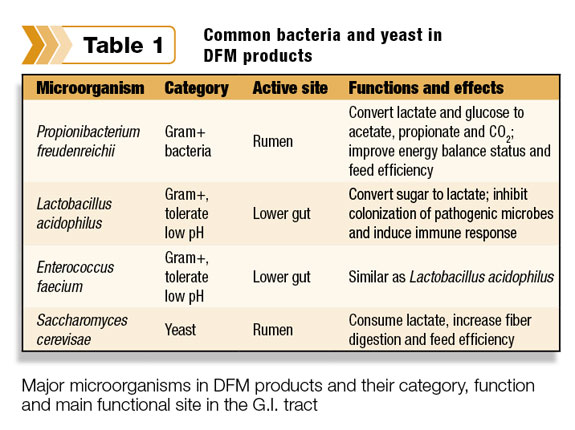Direct-fed microbials (DFM) are a source of live, naturally occurring microorganisms used as feed additives in the dairy industry. DFM are primarily composed of beneficial bacteria and live fungi (yeast) and have been recommended for use in cattle to mitigate rumen dysfunction and the effects of being off-feed and to improve feed efficiency, cow health and production performance.
Table 1 summarizes common bacteria and yeast in DFM products.

Dairy cows usually have decreased feed intake during the transition period, thereby experiencing a negative energy balance and rendering them more susceptible to pathogen invasion or to âopportunisticâ pathogens. Dairy farmers typically switch cows to a higher-grain diet immediately after calving to increase energy intake, contributing to a more acidic rumen environment.
These scenarios may warrant the use of DFM. A recent field study found that feeding a DFM had marginal improvements in milk yield and milk components and significantly reduced the need to treat cows with antibiotics in second-lactation cows after calving.
Another study reported changes in rumen fermentation without effect on milking performance. Two earlier studies found more obvious beneficial effects such as significantly increased feed intake and milk yield and improvements in metabolic profiles.
Despite validated successful use of DFM for early lactation cows, the magnitude of benefits is varied. In the four studies discussed above, different species and combinations of bacteria and yeast were used and the difference of dietary starch content between close-up and lactation diets was much greater in the two earlier studies.
This may have contributed to the greater beneficial response to DFM observed in these studies. Dairy farmers should consider the following points when making a decision whether to use DFM in diets for transition cows, such as:
- Get all the information about the composition of the DFM products, including strains of bacteria and recommended dosage.
- Understand whether the DFM product was evaluated by controlled research studies.
- Monensin targets gram-positive bacteria, so inquire about the potential loss in effectiveness of DFM if you are using Monensin.
- Be sure to acknowledge the difference in starch content between your close-up diet and lactation diet.
- Some bacterium, such as Propionibacterium, is intolerant to low pH. Information about potential losses when mixing with low-pH silage should be requested. PD
References omitted due to space but are available upon request. Click here to emil an editor.
âExcerpts from Miner Institute Farm Report , January 2012
Peng Ji is a postdoctoral researcher with the Miner Insitute. Email Peng Ji .





